There are many common causes of dog deaths that frequently get discussed, but blue green algae is one very real hazard that often catches dog parents unaware. Integrative veterinarian Dr. Julie Buzby is here to spread the word and arm you with information about blue green algae toxicity in dogs. Get the facts so you can safeguard your canine companion from this toxin.

Blue green algae + dogs = Danger!
I heard two very tragic stories recently—one from a veterinary client and one from a fellow veterinarian. I share both accounts here, not to scare you, but to help spread the word about the tragic consequences of a toxin that doesn’t receive as much media attention as xylitol in dogs or chocolate toxicity in dogs. It strikes lightning fast and has deadly consequences.
By sharing these true stories, I hope to honor the memories of these dear dogs and help prevent future tragedies.
A few weeks ago, a fellow veterinarian received a distressed call from her parents saying that their 3-year-old Aussie was acting funny and might be having a seizure. Alarmed, the veterinarian jumped in the car and headed over to her parent’s farm, which was right next to hers. Sadly, when she got there, the dog had already died.
They soon made a second horrifying discovery—her parent’s other dog, a 10-year-old Aussie, was also dead. Everyone was devastated. Her parent’s formerly lively house was now silent and dog-less.
The second story was shared by one of my veterinary clients. His young Golden Retriever had been frolicking in a nearby pond and quite suddenly died in the water. The dog’s tragic death happened within minutes. There was no practical treatment. There was nothing the dog parent could do.
The culprit in both of these cases? Blue green algae that produces toxins hazardous to humans and potentially fatal to dogs.
In the case of the first story of the two Aussies, an irrigation canal two properties over from them later tested positive for blue green algae and its toxins. The family thinks irrigation water must have pooled on top of a bucket, and the dogs both drank from it while outside going potty that morning.
To understand more about this toxin and to protect your dear dog, please read on.
What is blue green algae?
While the name suggests that this toxin is an algae (i.e. simple aquatic plant), it’s actually a toxic microorganism called cyanobacteria. This poisonous microscopic bacteria is often found in stagnant water but can be found in any amount or type of water.
Toxic “blooms” have been described as looking like “paint” floating on top the water. Outbreaks are most common in the summer months.
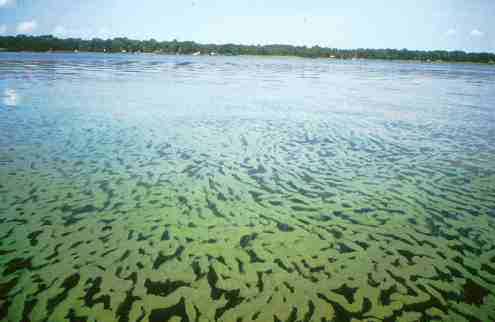
Why is blue green algae dangerous to dogs?
Sadly, toxins from blue green algae may be ingested as easily as a dog innocently lapping up a few sips of the water that’s essentially poisoned. In other instances, a dog may ingest the toxins simply by licking his fur after wading in contaminated water. There have also been reports of toxicity after well-meaning pet parents have given their dogs over-the-counter supplements containing blue green algae. Death for the dog can occur in 20 to 30 minutes.
What are the symptoms of blue green algae poisoning?

In dogs (and other animals), the toxins in blue green algae have a tendency to primarily damage both the liver (like many toxins) and the nervous system. Symptoms of poisoning include:
| Muscle tremors | Salivation |
| Vomiting | Dilated pupils |
| Diarrhea | Seizures |
| Weakness | Collapse |
| Rigid muscles | Respiratory failure |
| Pale or blue gums | Sudden death |
Where can blue green algae be found?
Also known as cyanobacteria or cyanobacterial blooms, blue green algae can be found in:
- Natural and man-made ponds
- Ponds set in landscaping in the yard
- Standing water
- Fresh water
- Lakes
- Brackish water
- Oceans
- Rivers
- Puddles
- Water troughs or buckets
How can I tell the difference between toxic blue green algae and generic pond scum?
Unfortunately, the answer to this question isn’t what you want to hear. Determining whether algae is toxic requires an expert to identify toxic cyanobacteria in a water sample. A handful of veterinary diagnostic labs also have specific assays that can detect the presence of the toxins.
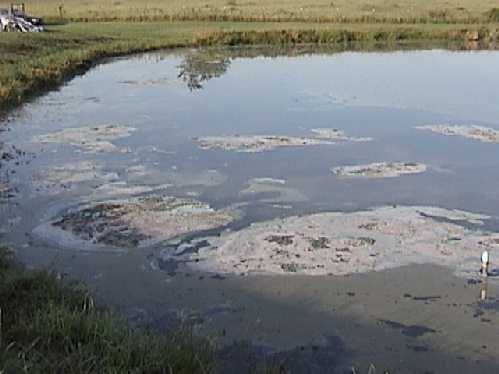
Additionally, the name “blue green algae” can be a bit misleading since cyanobacteria can be red or pink, in addition to the expected bluish green. However, I believe it’s important to have a general idea of what blue green algae looks like. (I am a firm believer that a picture is worth a thousand words.) There are several photos of toxic blue green algae throughout this article, including the one below.
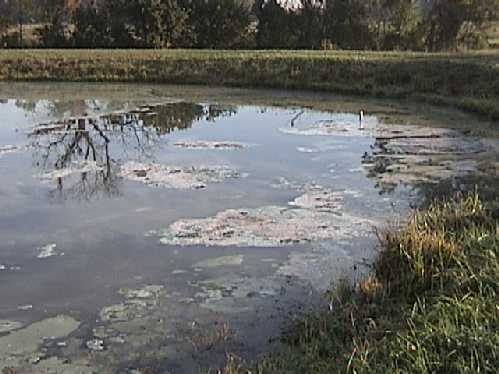
In addition to the water’s appearance, you can also look at other species in the water. If you seen dead fish or other dead animals around or in the water, it may be due to toxic blue green algae.
Are all cyanobacterial algae blooms toxic to dogs?
Although more than 2,000 species of cyanobacteria exist, only 40 of them are toxic to vertebrates. However, researchers estimate that 25 to 75% of cyanobacterial blooms are toxic. There’s no reason to take the chance. Keep your dogs (and children and yourself) away from water with algae and err on the side of caution.
CAUTION: Blue green algae and dogs just don't mix! Click To TweetHow long has blue green algae been around?
The toxins from cyanobacteria have harmed humans and animals for thousands of years.
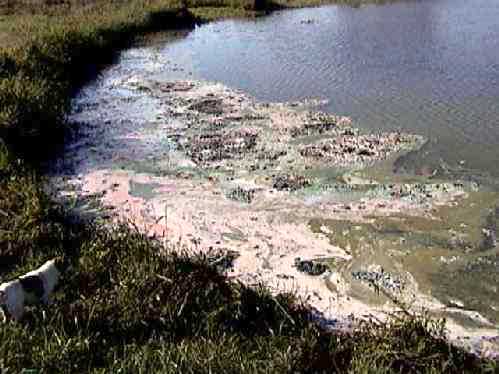
When is blue green algae at its worst?
Blue green algae is both a regional problem and a seasonal problem. It’s at its worst during periods of hot weather when the water is warm, but growth can occur at cooler temperatures too. Lack of rain or an influx of nitrogen and phosphorus may also contribute to algae blooms. When blooms occur, this creates pockets of toxins that may move from place to place or eventually dissipate.
Often local authorities at lakes or parks recognize the risk and take appropriate precautions by closing lakes to the public during a bloom.
What should I do if I suspect blue green algae poisoning?
If you suspect that your dog has come in contact with toxic blue green algae, seek veterinary care immediately at the nearest clinic. Even a few laps of water or wading in a few feet can be highly dangerous to dogs if the water contains the toxins. Severe signs and death may occur within minutes to hours, so time is of the essence. Unfortunately, since this toxin works incredibly fast, some dogs may not even survive long enough to get to the vet.
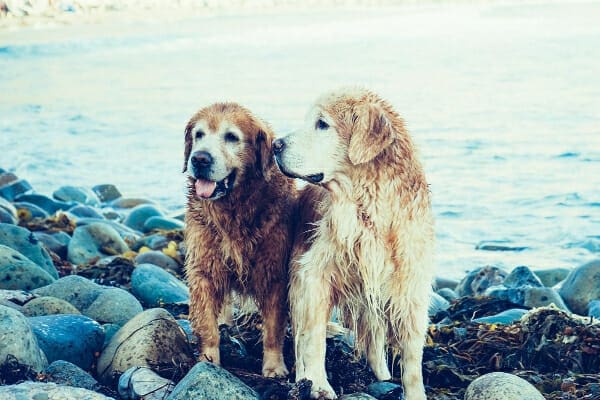
Blue green algae on your dog’s coat can cause skin irritation in humans. Wear gloves or wrap your dog in a towel if possible on your way to the vet to minimize your contact with the algae. Consult your physician if you are concerned that you may have had contact with toxic blue green algae.
Unfortunately, there is no antidote for blue green algae toxicity. Your vet will do his or her best to manage your dog’s symptoms with GI protectants, liver-protectants, fluid support, seizure control, and other supportive therapies. Getting your dog veterinary care ASAP gives your dog the best chances of survival. But, unfortunately, the overall prognosis is still guarded to poor. This is why prevention is the best medicine.
How can I keep my dog safe from this toxin?
Most dogs enjoy swimming or wading in water, especially in the summer. Alternatively, when you are hiking, it may be natural for your dog to want to grab a sip of water from a pond or puddle. However, if the water has scum on it, run—don’t walk—the other way.
Since the only way to be 1000% sure the water doesn’t contain cyanobacterial toxins is to have it looked at by an expert or run a diagnostic assay, it’s better to avoid the situation altogether. You and your dog will be glad you did.

If you have water on your property and your dog has free roam, keep a close eye on any areas where water collects—water troughs, buckets, streams, ponds—to ensure you don’t see signs of blue green algae. If you see anything suspicious, keep your dog out of that area. When walking or hiking with your pup, carry fresh water and a bowl for him or her and offer frequent water breaks.
Keep in mind that if you use an algaecide on the water, it will kill cyanobacteria but toxic strains of cyanobacteria release high levels of toxins as they die. These toxins may persist in the water for several weeks after the cyanobacteria are gone.
Where can I learn more about blue green algae and dogs?
If you have questions or concerns about the hazards of blue green algae for your dog, please speak with your veterinarian, or read more about toxic algal blooms at USGS.gov (United States Geological Survey).
For more images of cyanobacterial blooms, please visit Cyanosite.com, a research site supported by Biological Sciences at Purdue University and by Wichita State University. A special thank you to Mark at Wichita State University for permission to share images of cyanobacterial blooms so that we can inform our readers about blue green algae.
Finally, as an integrative veterinarian and founder of Dr. Buzby’s ToeGrips, my mission is to help you help your dog live the longest, happiest, healthiest life possible. Please help spread the word about this toxin that is dangerous to dogs, so that other pet parents are informed. If we all work together, we can help keep our dear dogs safe and prevent future tragedies.

What questions do you have about blue green algae and dogs?
Please comment below.


We have a 13 year od Yorkshire Terrier whose name is Dillon and he has been found he has high liver enzymes. He has blood tests every 6 weeks and it is still high. Our vet has put him on antibiotics, Probiotics for liver and vitamins to help the liver function better but recently he has gotten soft stools so we put him on gastro? food and still the stools are soft. He hasn’t wanted to eat but I think he is tired of the dog food. so I have been trying to give him cooked hamburger 2% fat and I pat the fat out before serving and shredded cheese. What else can I do? I,m not ready to say goodbye.
Dear Pamela,
I am sorry you are facing this difficult situation with Dillon. I understand your concern as his health continues to decline. Without playing a personal role in his medical care it is hard to give specific recommendations. Here are links to other articles about liver disease that may offer new information:
1. High Liver Enzymes in Dogs: A Vet Explains What It Means
2. Liver Disease in Dogs: Signs, Symptoms, Causes, Treatment
3. When to Euthanize A Dog With Liver Failure: A Vet’s Advice
Hoping you can partner with your vet to find a way to restore your sweet boy’s quality of life. Praying for healing and wishing you both all the best.
Thanks you Dr. Buzby for sharing this important warning. I have no idea. Good to spread the word of the dangers of blue-green algae for humans and dogs!
You are so welcome, Kim. This is a real and serious risk in certain regions. I appreciate your comment!